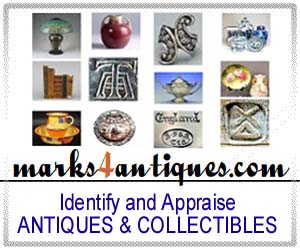APPRAISALS & ANTIQUES VALUES
Part II – What is an Appraisal?
To find prices and determine values for your antiques & collectibles of any kind, please see our Price Guides with millions of examples of items sold.

In Part I we explored the formal definitions of what constitutes the "value" of an antique or collectible item, taking into account its intended usage. In this next section, we will delve into the different appraisal practices that collectors and dealers can use to determine the worth of their items. We will begin by discussing the formal or official appraisal method, which is the most traditional and rigorous, before moving on to several alternative approaches that are generally faster and more affordable.
A formal or official appraisal as accepted by most legal entities (Tax Authorities, the Legal System & Courts, Banks, Insurance companies etc) embodies a
series of actions, including at least the following:
• A close inspection of the items to be appraised
• Condition Reports
• Thorough research for comparable items to establish values with at least three (3) similar items clearly documented, and
• A very carefully written and detailed Appraisal Report
Formal appraisals are a crucial tool in the world of Antiques & Collectibles, and they're usually carried out by certified appraisers who are members of prestigious associations such as the International Society of Appraisers (ISA) or the American Society of Appraisers (ASA). These accredited appraisers charge by the hour, and often include additional expenses such as transportation. However, before starting the process, they usually provide clients with an estimate of the costs involved.
It's worth noting that the cost of a formal appraisal can vary significantly. For just a few items, prices can range from $400 to $3,000, and in some cases, the cost may exceed $10,000. As a result, formal appraisals are generally reserved for situations that require official documentation, such as dealing with the IRS, Divorce or Inheritance Disputes, or Financial Inquiries. These appraisals can take several days or even weeks to complete due to their rigorous nature.
However, for the vast majority of antiques dealers or collectors, formal appraisals are not always necessary. In most cases, the focus is on determining fair and reasonable prices for items that are either being sold or purchased. While experience is a crucial factor in these situations, market trends and unique circumstances can require a bit more legwork. So, while formal appraisals may be necessary in some circumstances, there are other options available to those who simply need to assign value to their collections.
Experienced dealers in the world of Antiques & Collectibles understand that the initial step in the selling process, whether in-person at Antiques Fairs & Shows or through a physical or online shop, is identifying the item. This is especially crucial when it comes to "smalls" such as porcelain, chinaware, silver, jewelry, and other delicate items, which often have identifying marks that can be used to determine their age and maker. Alongside an item's condition, including any signs of damage, wear and tear, or prior repairs, this information is essential in determining its value.
Nowadays, there are countless resources available to dealers and collectors to aid in this identification process. Annual Price Guides and websites dedicated to researching antiques & collectibles based on their maker and age have become invaluable tools for those seeking to assign a value to their items. These resources have made it easier than ever before to access the necessary information to make informed decisions when it comes to buying, selling, or valuing antiques and collectibles.

In today's fast-paced world, traditional Price Guide books have become outdated and cumbersome, requiring annual updates and taking up valuable space. Instead, the Internet has emerged as the most popular resource for researching antiques and collectibles. Many collectors and dealers turn to online sales sites such as eBay for information, viewing them as reliable resources, but it is important to note that there are limitations to this approach.
For instance, one must assume that the seller has accurately identified the item and priced it appropriately. However, if an item does not sell, it may be difficult to determine if it was priced too high or if there simply isn't much interest in that particular item at the current time due to market trends. As such, it is crucial to not only confirm the maker and age of an item when researching online but also to concentrate on listings that have actually sold.
By focusing on sold listings, collectors and dealers can gain valuable insights into the actual market value of an item, allowing them to make more informed buying and selling decisions. In combination with traditional research methods, such as consulting with experts and utilizing other reference materials, the Internet can be a valuable tool in determining the worth of antiques and collectibles..
One of the challenges we faced early on when creating our database for our Price Guide, was how each dealer or collector used different terms or names for certain items. For example, a Porcelain Figurine is also called Porcelain Figure, a Silver Tray is called Silver Salver if it has feet, a Pitcher is also known as Jug etc. For this reason, we have a built-in sophisticated translation program that “understands” what you mean when you search our site. This turned out to be a huge improvement for our research services since the results are more relevant and accurate.
Additionally, knowing how important it is to find results quickly and efficiently, we designed our site so that it shows all results in actual pictures. For instance, on a search for “Royal Doulton Figurine”, our members can view a number of examples that actually sold at several auction houses and quickly pick the ones that are similar to the item under evaluation. They can then select as many as needed to see them with larger photos and more details on another page. This “Compare” feature has been a time saver for our members and isolates the items that are of real interest in a quick reference format, which you can print for your records.
We are proud to have many professional appraisers from both ISA and ASA as long-standing members, a testament to the fact that our results are accurate and hold up to the highest standards.
In summary, giving due diligence to researching your collection is crucial as numerous factors can influence the final evaluation. Ensuring accurate identification and appraisal of your items will boost your confidence in pricing them correctly and achieving a successful sale or fair trade.
Unlock the true value
of your collection with our comprehensive research guides from identifying makers' marks to appraising all kinds of
antiques and collectibles.
Our up-to-date information will give you an accurate understanding of your items' worth. Don't miss out on this
valuable resource - visit our research tools today!
Search our price guide for your
own treasures.





